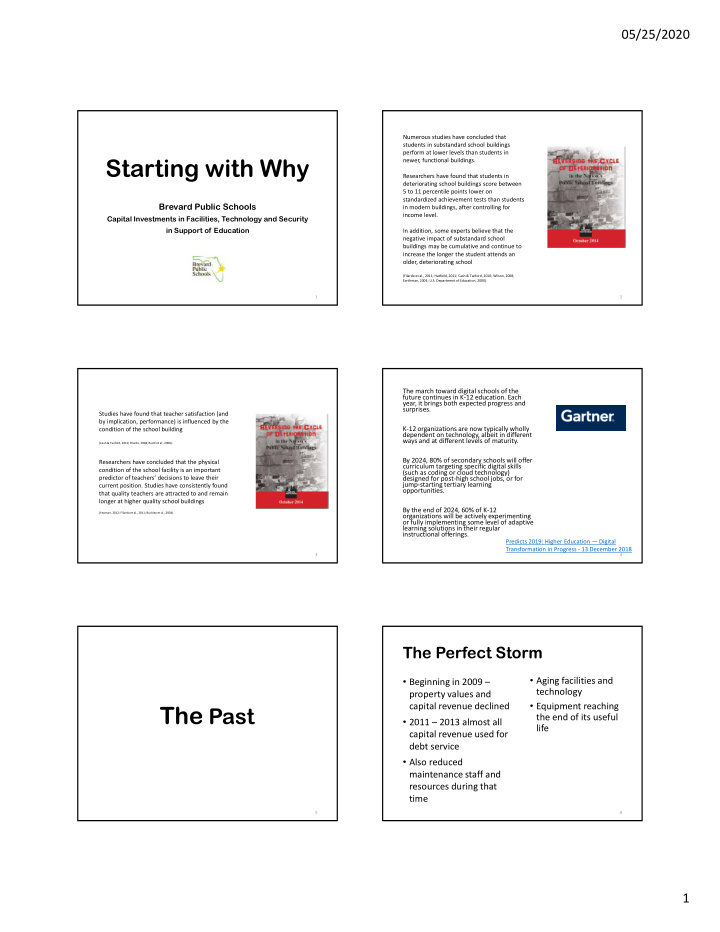



05/25/2020 Numerous studies have concluded that students in substandard school buildings perform at lower levels than students in Starting with Why newer, functional buildings. Researchers have found that students in deteriorating school buildings score between 5 to 11 percentile points lower on standardized achievement tests than students Brevard Public Schools in modern buildings, after controlling for income level. Capital Investments in Facilities, Technology and Security in Support of Education In addition, some experts believe that the negative impact of substandard school buildings may be cumulative and continue to increase the longer the student attends an older, deteriorating school (Filardo et al., 2011; Hatfield, 2011; Cash & Twiford, 2010; Wilson, 2008; Earthman, 2004; U.S. Department of Education, 2000). 1 2 The march toward digital schools of the future continues in K‐12 education. Each year, it brings both expected progress and surprises. Studies have found that teacher satisfaction (and by implication, performance) is influenced by the K‐12 organizations are now typically wholly condition of the school building dependent on technology, albeit in different ways and at different levels of maturity. (Cash & Twiford, 2010; Filardo, 2008; Rudd et al., 2008). By 2024, 80% of secondary schools will offer Researchers have concluded that the physical curriculum targeting specific digital skills condition of the school facility is an important (such as coding or cloud technology) predictor of teachers’ decisions to leave their designed for post‐high school jobs, or for jump‐starting tertiary learning current position. Studies have consistently found opportunities. that quality teachers are attracted to and remain longer at higher quality school buildings By the end of 2024, 60% of K‐12 (Yeoman, 2012; Filardo et al., 2011; Buckley et al., 2004). organizations will be actively experimenting or fully implementing some level of adaptive learning solutions in their regular instructional offerings. Predicts 2019: Higher Education — Digital Transformation in Progress ‐ 13 December 2018 3 4 The Perfect Storm • Aging facilities and • Beginning in 2009 – technology property values and • Equipment reaching The Past capital revenue declined the end of its useful • 2011 – 2013 almost all life capital revenue used for debt service • Also reduced maintenance staff and resources during that time 5 6 1
05/25/2020 The 2014 Sales Surtax Concept What was Funded? • Original facility assessments done in spring/summer 2014 • Basis of the sales surtax referendum • Systems rated 1 (failing) – 5 (almost new) • Estimates based on generalized costs • From this data base, developed “Attachment F” – funded project – for each school 7 8 Surtax Funding for Surtax Funding for Facility Renewal Educational Technology Safety Code Deficiencies $ 7,020,395 4% Mechanical (HVAC, plumbing) $ 106,764,617 68% Technology Cabling $ 6,292,510 25% Building Envelope $ 21,125,267 13% Technology Equipment Renewal $ 11,177,953 44% Electrical $ 18,150,754 12% Classroom Technology Infrastructure $ 7,894,726 31% Site Utilities $ 3,908,967 2% Educational Technology Total $ 25,365,189 100% Facility Renewal Total $ 156,970,000 This represented about 22% of the identified facility renewal needs in This represented about 93% of the surtax related identified Technology 2014! Education needs in 2014! Sales surtax revenue exceeded expectations. Facility renewal investment is now at about 25% of needs identified in 2014. 9 10 11 12 2
05/25/2020 The Present 13 14 Contributions from General Revenue from Sales Tax (with CST*) Collections in FY 2017‐2018 by Source Tourists 13.4% Business Source: State of 23.4% Florida Long‐Range Financial Outlook ‐ Fiscal Years 21‐23 ‐ September 2019 *Communications Services Tax Households 63.2% $45 million per year revenue (pre‐Covid); 228,88 households (July 1, 2018) – roughly $124/household per year paid in sales surtax 15 16 Pre-Covid Projection Basis of Post-Covid Projection 2020 2021 2022 2023 2024 2025 2026 2027 Projected Revenue over $198 Million January 0.75 0.825 0.85 0.875 0.9 0.925 0.95 Month Revenue Cumulative February 0.75 0.825 0.85 0.875 0.9 0.925 0.95 March 0.80 0.825 0.85 0.875 0.9 0.925 0.95 August $1,294,012 $1,294,012 April 0.80 0.825 0.85 0.875 0.9 0.925 0.95 September $3,474,204 $4,768,216 May 1.00 0.80 0.825 0.85 0.875 0.9 0.925 0.95 October $3,440,101 $8,208,317 June 0.60 0.80 0.825 0.85 0.875 0.9 0.925 0.95 November $4,526,234 $12,734,551 July 0.60 0.80 0.825 0.85 0.875 0.9 0.925 0.95 December $3,425,373 $16,159,924 August 0.65 0.80 0.825 0.85 0.875 0.9 0.925 0.95 January $3,477,814 $19,637,738 September 0.65 0.80 0.825 0.85 0.875 0.9 0.925 0.95 February $5,470,970 $25,108,708 October 0.70 0.80 0.825 0.85 0.875 0.9 0.925 0.95 March $3,471,004 $28,579,712 November 0.70 0.80 0.825 0.85 0.875 0.9 0.925 0.95 April $3,505,366 $32,085,078 December 0.70 0.80 0.825 0.85 0.875 0.9 0.925 0.95 May $5,389,791 $37,474,869 June $3,554,107 $41,028,976 July $3,574,694 $44,603,670 Coefficients applied against CY 2019 revenue stream to estimate future revenue August $4,954,442 $49,558,112 Assume significant revenue decline June, July due to April, May COVID impacts September $3,474,204 $53,032,316 Assumes increasing revenue during recovery from COVID to about 80% of prior economic activity October $3,440,101 $56,472,417 Assumes about 3% annual increase moving forward November $4,526,234 $60,998,651 December $3,425,373 $64,424,024 January $3,477,814 $67,901,838 February $5,420,075 $73,321,913 Total $73,321,913 Estimated based on prior year receipts ‐ not adjusted for COVID‐19 impacts 17 18 3
Recommend
More recommend